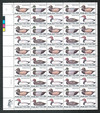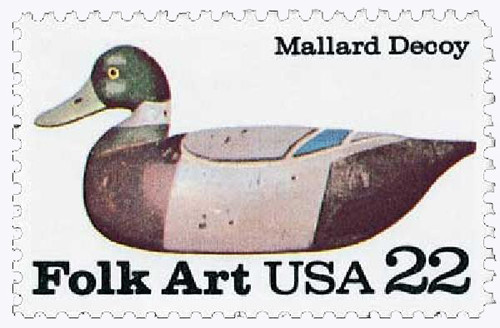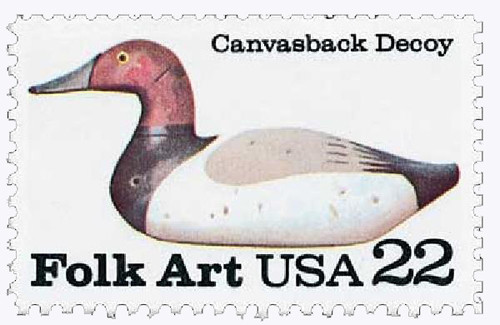
# 2138-41 - 1985 22c Broadbill Duck Decoys
U.S. #2138-41
1985 22¢ Duck Decoys
American Folk Art Series
- Fourth issue in the Folk Art Series
- Pictures four antique duck decoys crafted between the 1890s and 1930
Stamp Category: Commemorative
Series: American Folk Art Series
Value: 22¢; first-class rate
First Day of Issue: March 22, 1985
First Day City: Shelburne, Vermont
Quantity Issued: 300,000,000
Printed by: American Banknote Company
Printing Method: Photogravure
Format: Panes of 50 in sheets of 200
Perforations: 11
Why the stamps were issued: To honor the artistry of duck decoys.
About the stamp designs: These stamps were painted by Stevan Dohanos, who had designed 29 stamps and three postal cards up to that time. He based his stamp art on authentic duck decoys. Two of these decoys are part of the collection of the Shelburne Museum, site of the First Day of Issue ceremony for these stamps.
- The canvasback decoy stamp was based on a decoy carved by Bob McGaw of Havre De Grace, Maryland, in 1929.
- The mallard stamp depicts a 1930 decoy crafted by Percy Grant of Osbornsville, New Jersey, in 1930.
- The broadbill decoy was created Ben Holmes of Stratford, Connecticut, in the 1890s.
- The redhead decoy was made by Keyes Chadwick of Martha’s Vineyard in 1925.
First Day City: The First Day ceremony for these stamps was held at the Shelburne Village School in Shelburne, Vermont, near the Shelburne Museum, which is home to more than 1,300 duck decoys. During the ceremony, a postal official called these decoys “true folk sculpture, so true to life that many of them are now attacked by cats. They are no longer simply an adjunct to hunting.”
Unusual fact about these stamps: These stamps have been found misperfed, with perforations running through the ducks’ heads.
About the American Folk Art Series: The USPS created the Folk Art Series in 1977 to honor important and lesser-known items in American art and culture. Folk Art is loosely defined as the art of the everyday, rooted in traditions that come from community and culture and expressing cultural identity by conveying shared community values and aesthetics. The series lasted nearly 20 years and featured folk art including Pueblo pottery, quilts, Pennsylvania toleware, Pacific Northwest Indian Masks, duck decoys, Navajo Blankets, wood-carved figures, lacemaking, carousel animals, Indian headdresses, and carousel horses. Click here for more about the series.
History the stamps represent: There’s evidence of duck decoys dating back to ancient Egypt – illustrations of King Tutankhamen holding decoys. Duck decoys were also discovered in a Nevada cave dating back to around 1000 A.D. Crafted by a tribe known as the Tule Eaters, they were filled with feathers and bult with woven reeds. These are believed to be the oldest duck decoys in America.
As with many antiques, duck decoys were first used in a practical manner. Hunters would set the decoys out on the water or coastline to try to fool birds into thinking an area was safe. The decoys became more and more detailed in order to make them more effective. Eventually the carving and painting of decoys became a hobby – and art form – in its own right.
U.S. #2138-41
1985 22¢ Duck Decoys
American Folk Art Series
- Fourth issue in the Folk Art Series
- Pictures four antique duck decoys crafted between the 1890s and 1930
Stamp Category: Commemorative
Series: American Folk Art Series
Value: 22¢; first-class rate
First Day of Issue: March 22, 1985
First Day City: Shelburne, Vermont
Quantity Issued: 300,000,000
Printed by: American Banknote Company
Printing Method: Photogravure
Format: Panes of 50 in sheets of 200
Perforations: 11
Why the stamps were issued: To honor the artistry of duck decoys.
About the stamp designs: These stamps were painted by Stevan Dohanos, who had designed 29 stamps and three postal cards up to that time. He based his stamp art on authentic duck decoys. Two of these decoys are part of the collection of the Shelburne Museum, site of the First Day of Issue ceremony for these stamps.
- The canvasback decoy stamp was based on a decoy carved by Bob McGaw of Havre De Grace, Maryland, in 1929.
- The mallard stamp depicts a 1930 decoy crafted by Percy Grant of Osbornsville, New Jersey, in 1930.
- The broadbill decoy was created Ben Holmes of Stratford, Connecticut, in the 1890s.
- The redhead decoy was made by Keyes Chadwick of Martha’s Vineyard in 1925.
First Day City: The First Day ceremony for these stamps was held at the Shelburne Village School in Shelburne, Vermont, near the Shelburne Museum, which is home to more than 1,300 duck decoys. During the ceremony, a postal official called these decoys “true folk sculpture, so true to life that many of them are now attacked by cats. They are no longer simply an adjunct to hunting.”
Unusual fact about these stamps: These stamps have been found misperfed, with perforations running through the ducks’ heads.
About the American Folk Art Series: The USPS created the Folk Art Series in 1977 to honor important and lesser-known items in American art and culture. Folk Art is loosely defined as the art of the everyday, rooted in traditions that come from community and culture and expressing cultural identity by conveying shared community values and aesthetics. The series lasted nearly 20 years and featured folk art including Pueblo pottery, quilts, Pennsylvania toleware, Pacific Northwest Indian Masks, duck decoys, Navajo Blankets, wood-carved figures, lacemaking, carousel animals, Indian headdresses, and carousel horses. Click here for more about the series.
History the stamps represent: There’s evidence of duck decoys dating back to ancient Egypt – illustrations of King Tutankhamen holding decoys. Duck decoys were also discovered in a Nevada cave dating back to around 1000 A.D. Crafted by a tribe known as the Tule Eaters, they were filled with feathers and bult with woven reeds. These are believed to be the oldest duck decoys in America.
As with many antiques, duck decoys were first used in a practical manner. Hunters would set the decoys out on the water or coastline to try to fool birds into thinking an area was safe. The decoys became more and more detailed in order to make them more effective. Eventually the carving and painting of decoys became a hobby – and art form – in its own right.


















